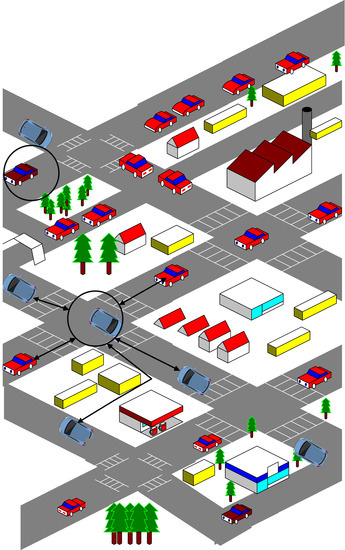DIFTOS: A Distributed Infrastructure-Free Traffic Optimization System Based on Vehicular Ad Hoc Networks for Urban Environments
Abstract
:1. Introduction
- DIFTOS is completely infrastructure-less and does not rely on any other network (cellular network, RSU), and it is totally distributed and does not rely on a centralized server.
- DIFTOS is designed in a hierarchical fashion, thus short length path requests are resolved locally, and does not need to travel long distances.
- To demonstrate the validity of DIFTOS, we have conducted a thorough comparison with existing approaches.
2. Related Works
3. System Architecture
3.1. Assumptions
- All vehicles are equipped with a dedicated short-range communication (DSRC) device.
- All vehicles are equipped with a GPS-based navigation system that has a digital roadmap.
- All communications are done using multi-hop vehicle-to-vehicle communication model (V2V).
- Drivers input the destination into their GPS-based navigation system as a navigation request when they start traveling. The VVS computes the shortest non-congested path and reserves it for them.
- Vehicles report the updates about their travel experience in road segments and at intersections along their travel path to their corresponding VVS.
- Since the travel paths are very sensitive information, all the communications between DIFTOS-Client and DIFTOS-Server are encrypted.
- The road segments are reserved in the order of a first come first served policy.
3.2. System Components
3.2.1. DIFTOS-Client
3.2.2. DIFTOS-Server
3.3. Virtual Vehicular Server
3.3.1. Hierarchical Partitioning
3.3.2. Server Selection
4. System Modelling
4.1. Notations
4.2. Road Network Graph
4.3. Traffic Flow and Travel Delay
4.4. Road Reservation Matrix
4.5. Problem Formulation
4.6. Priority Quota
4.7. Shortest Path and Road Rerouting
| Algorithm 1 Priority Quota Constrained Shortest Path |
| 1: Function Shortest-Path-Quota-Priority () |
| 2: , |
| 3: for each road segment do |
| 4: if () then |
| 5: |
| 6: if () then |
| 7: |
| 8: end if |
| 9: end if |
| 10: end for |
4.8. Path Reservation
4.8.1. Path Request
4.8.2. Path Reply
4.8.3. Path Update
5. Simulation
5.1. Map Extraction
5.2. Network Simulation
V2V Communication Parameters
6. Performance Evaluation
6.1. Baseline
6.2. Metrics
- Request Round Trip Time (RRTT): The time required to send a path request packet and receive the path reply.
- Computation Cost (CC): The number of operations the server performs to determine the optimal path for a given RReq and maintain the road reservations.
- Trip Time (TT): The time required by a vehicle to reach its destination after receiving the RRep packet from the server.
- Traffic Messages (TM): The number of exchanged messages to compute and maintain the optimal path. In this context, only the traffic related messages are counted, such as route request messages, server election messages, route reply messages and route update messages.
6.3. Evaluation Parameters
6.4. Results Analysis
7. Conclusions
- The inter-vehicle communications are encrypted. However, as long as vehicles’ traces are fully disclosed, the user’s identity in some cases can be inferred even if pseudonyms are used. Therefore, DIFTOS still needs to be improved from the privacy point of view. Enhancing DIFTOS with an additional security and privacy framework is one of our future research directions.
- DIFTOS’s distributed architecture improves the scalability of the system and reduces the load on servers, as the path requests are treated as different servers. However, at upper-level servers, it becomes difficult for a single vehicle to maintain the RRM, due to the large size of data, and the huge amount of computation needed to resolve many path requests simultaneously. Therefore, optimizing DIFTOS to distribute the server calculation as a vehicular cloud server, where many vehicles collaborate to maintain RRM, is one of our future directions.
- The current hierarchical partition still needs improvements, as cross levels paths still need to solicit upper levels servers. In our next work, we will try to change the path request procedure, where two adjacent servers of the same level can cooperate to solve a path request without the need to forward it to higher level servers.
Author Contributions
Funding
Conflicts of Interest
References
- Schrank, D.; Eisele, B.; Lomax, T. TTI’s 2012 Urban Mobility Report; Texas A&M Transportation Institute: Dallas, TX, USA; The Texas A&M University System: College Station, TX, USA, 2012; p. 4. [Google Scholar]
- TomTom Navigator. Available online: www.tomtom.com (accessed on 6 June 2018).
- UNavi Navigator. Available online: http://unavi-usa.com (accessed on 6 June 2018).
- Waze Navigator. Available online: www.waze.com (accessed on 6 June 2018).
- Skobbler Navigator. Available online: https://www.skobbler.com/ (accessed on 6 June 2018).
- Son, S.; Baek, Y. Design and Implementation of Real-Time Vehicular Camera for Driver Assistance and Traffic Congestion Estimation. Sensors 2015, 15, 20204–20231. [Google Scholar] [CrossRef] [PubMed] [Green Version]
- Correa, A.; Boquet, G.; Morell, A.; Lopez Vicario, J. Autonomous Car Parking System through a Cooperative Vehicular Positioning Network. Sensors 2017, 17, 848. [Google Scholar] [CrossRef] [PubMed]
- El-Sayed, H.; Sankar, S.; Daraghmi, Y.-A.; Tiwari, P.; Rattagan, E.; Mohanty, M.; Puthal, D.; Prasad, M. Accurate Traffic Flow Prediction in Heterogeneous Vehicular Networks in an Intelligent Transport System Using a Supervised Non-Parametric Classifier. Sensors 2018, 18, 1696. [Google Scholar] [CrossRef] [PubMed]
- Messaoud, E.; El Idrissi, A.E.B.; Alaoui, A.E. The green dynamic vehicle routing problem in sustainable transport. In Proceedings of the 2018 4th International Conference on Logistics Operations Management (GOL), Le Havre, France, 10–12 April 2018; pp. 1–6. [Google Scholar]
- Santamaria, A.F.; Tropea, M.; Fazio, P.; De Rango, F. Managing Emergency Situations in VANET Through Heterogeneous Technologies Cooperation. Sensors 2018, 18, 1461. [Google Scholar] [CrossRef] [PubMed]
- Fazio, P.; De Rango, F.; Lupia, A. Vehicular Networks and Road Safety: An Application for Emergency/Danger Situations Management Using the WAVE/802.11p Standard. Adv. Electr. Electron. Eng. 2013, 11. [Google Scholar] [CrossRef]
- Parrado, N.; Donoso, Y. Congestion Based Mechanism for Route Discovery in a V2I-V2V System Applying Smart Devices and IoT. Sensors 2015, 15, 7768–7806. [Google Scholar] [CrossRef] [PubMed] [Green Version]
- Wang, M.; Shan, H.; Lu, R.; Zhang, R.; Shen, X.; Bai, F. Real-Time Path Planning Based on Hybrid-VANET-Enhanced Transportation System. IEEE Trans. Veh. Technol. 2015, 64, 1664–1678. [Google Scholar] [CrossRef]
- Wang, S.; Djahel, S.; Zhang, Z.; McManis, J. Next Road Rerouting: A Multiagent System for Mitigating Unexpected Urban Traffic Congestion. IEEE Trans. Intell. Transp. Syst. 2016, 17, 2888–2899. [Google Scholar] [CrossRef]
- Jeong, J.; Jeong, H.; Member, S.; Lee, E.; Oh, T.; Member, S.; Du, D.H.C. SAINT: Self-Adaptive Interactive Navigation Tool for Cloud-Based Vehicular Traffic Optimization. IEEE Trans. Veh. Technol. 2016, 65, 4053–4067. [Google Scholar] [CrossRef]
- Pan, J.S.; Popa, I.S.; Borcea, C. DIVERT: A Distributed Vehicular Traffic Re-Routing System for Congestion Avoidance. IEEE Trans. Mob. Comput. 2017, 16, 58–72. [Google Scholar] [CrossRef]
- Gao, J.H.; Peh, L.-S. RoadRunner: Infrastructure-less vehicular congestion control. In Proceedings of the 21st Intelligent Transport Systems World Congress, Detroit, MI, USA, 7–11 September 2014. [Google Scholar]
- Aldegheishem, A.; Yasmeen, H.; Maryam, H.; Shah, M.; Mehmood, A.; Alrajeh, N.; Song, H. Smart Road Traffic Accidents Reduction Strategy Based on Intelligent Transportation Systems (TARS). Sensors 2018, 18, 1983. [Google Scholar] [CrossRef] [PubMed]
- Banani, S.; Gordon, S.; Thiemjarus, S.; Kittipiyakul, S. Verifying Safety Messages Using Relative-Time and Zone Priority in Vehicular Ad Hoc Networks. Sensors 2018, 18, 1195. [Google Scholar] [CrossRef] [PubMed]
- Hu, M.; Zhong, Z.; Ni, M.; Baiocchi, A. Design and Analysis of A Beacon-Less Routing Protocol for Large Volume Content Dissemination in Vehicular Ad Hoc Networks. Sensors 2016, 16, 1834. [Google Scholar] [CrossRef] [PubMed]
- Garcia-Lozano, E.; Campo, C.; Garcia-Rubio, C.; Rodriguez-Carrion, A. A Bandwidth-Efficient Dissemination Scheme of Non-Safety Information in Urban VANETs. Sensors 2016, 16, 988. [Google Scholar] [CrossRef] [PubMed]
- García-Campos, J.M.; Sánchez-García, J.; Reina, D.G.; Toral, S.L.; Barrero, F. An evaluation methodology for reliable simulation based studies of routing protocols in VANETs. Simul. Model. Pract. Theory 2016, 66, 139–165. [Google Scholar] [CrossRef] [Green Version]
- Zhu, Y.; Li, Z.; Zhu, H.; Li, M.; Zhang, Q. A Compressive Sensing Approach to Urban Traffic Estimation with Probe Vehicles. IEEE Trans. Mob. Comput. 2013, 12, 2289–2302. [Google Scholar] [CrossRef]
- Soriguera, F.; Robusté, F. Estimation of traffic stream space mean speed from time aggregations of double loop detector data. Transp. Res. Part C Emerg. Technol. 2011, 19, 115–129. [Google Scholar] [CrossRef]
- Güner, A.R.; Murat, A.; Chinnam, R.B. Dynamic routing under recurrent and non-recurrent congestion using real-time ITS information. Comput. Oper. Res. 2012, 39, 358–373. [Google Scholar] [CrossRef]
- OpenStreetMaps. Available online: https://www.openstreetmap.org/ (accessed on 6 June 2018).
- OMNeT++ Discrete Event Simulator. Available online: https://www.omnetpp.org/ (accessed on 6 June 2018).
- The Open Source Vehicular Network Simulation Framework. Available online: http://veins.car2x.org/ (accessed on 6 June 2018).
- Shen, Y.; Lee, J.; Jeong, H.; Jeong, J.; Lee, E.; Du, D.H.C. SAINT+: Self-Adaptive Interactive Navigation Tool+ for Emergency Service Delivery Optimization. IEEE Trans. Intell. Transp. Syst. 2018, 19, 1038–1053. [Google Scholar] [CrossRef]
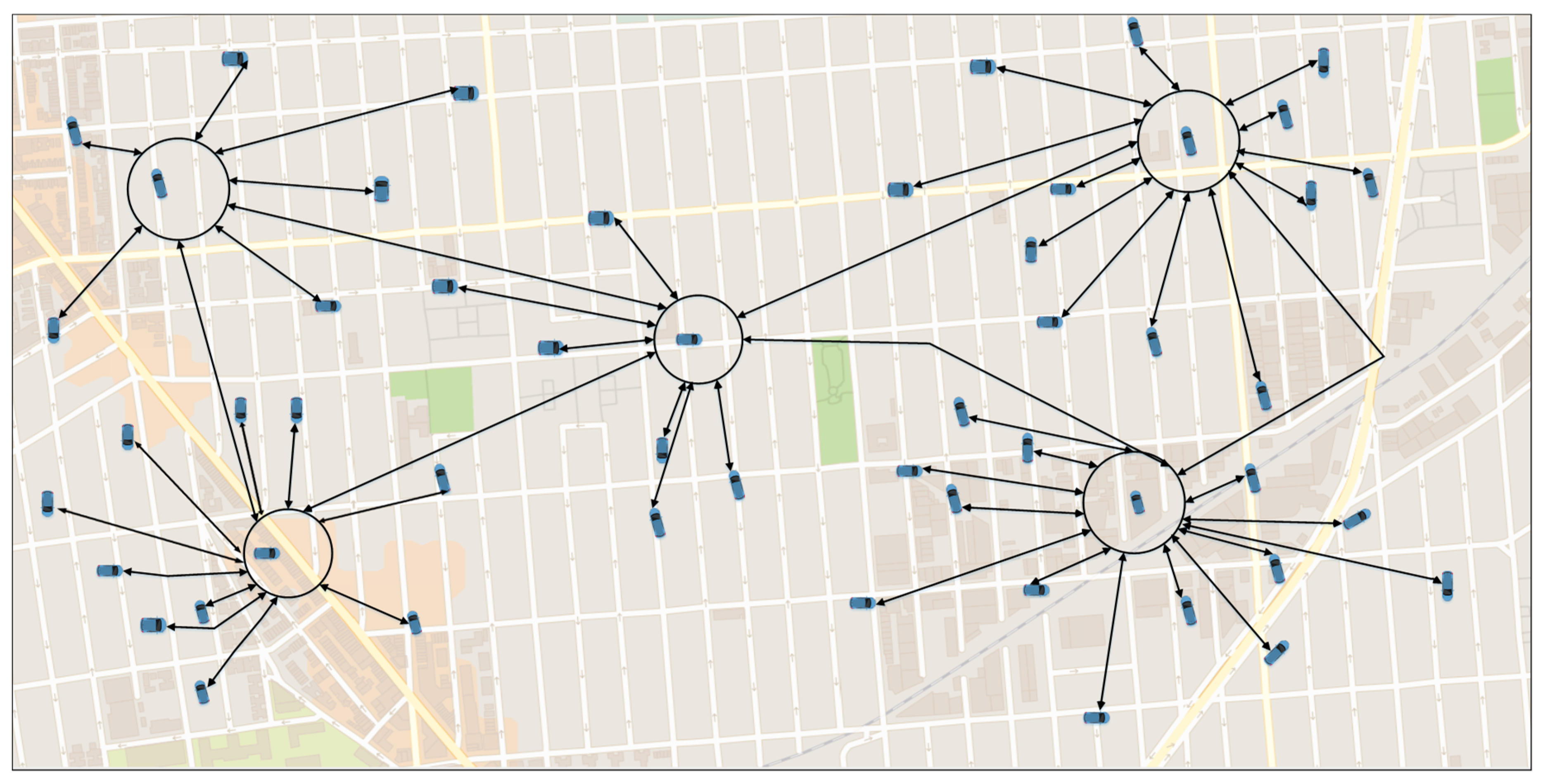
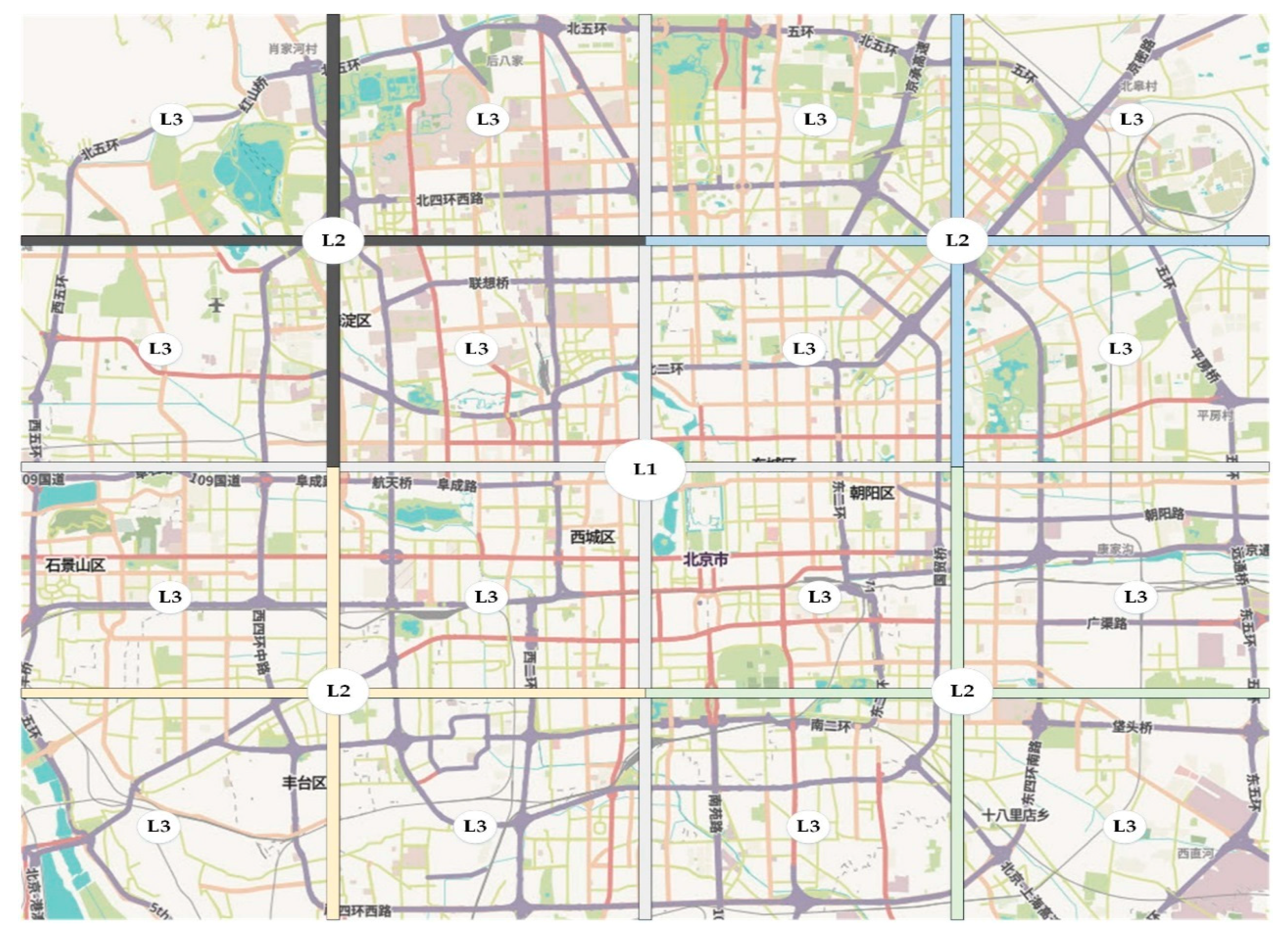
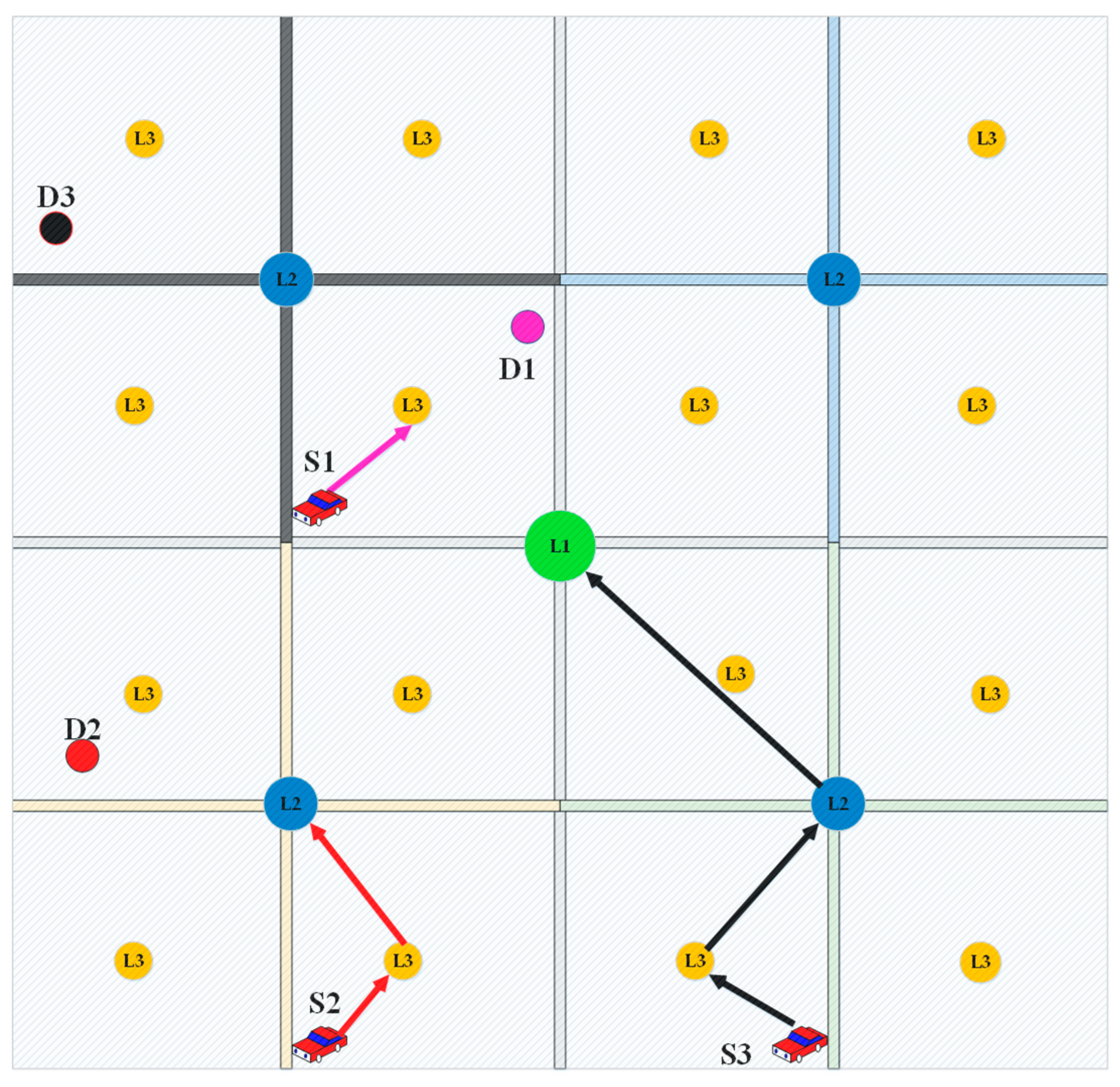
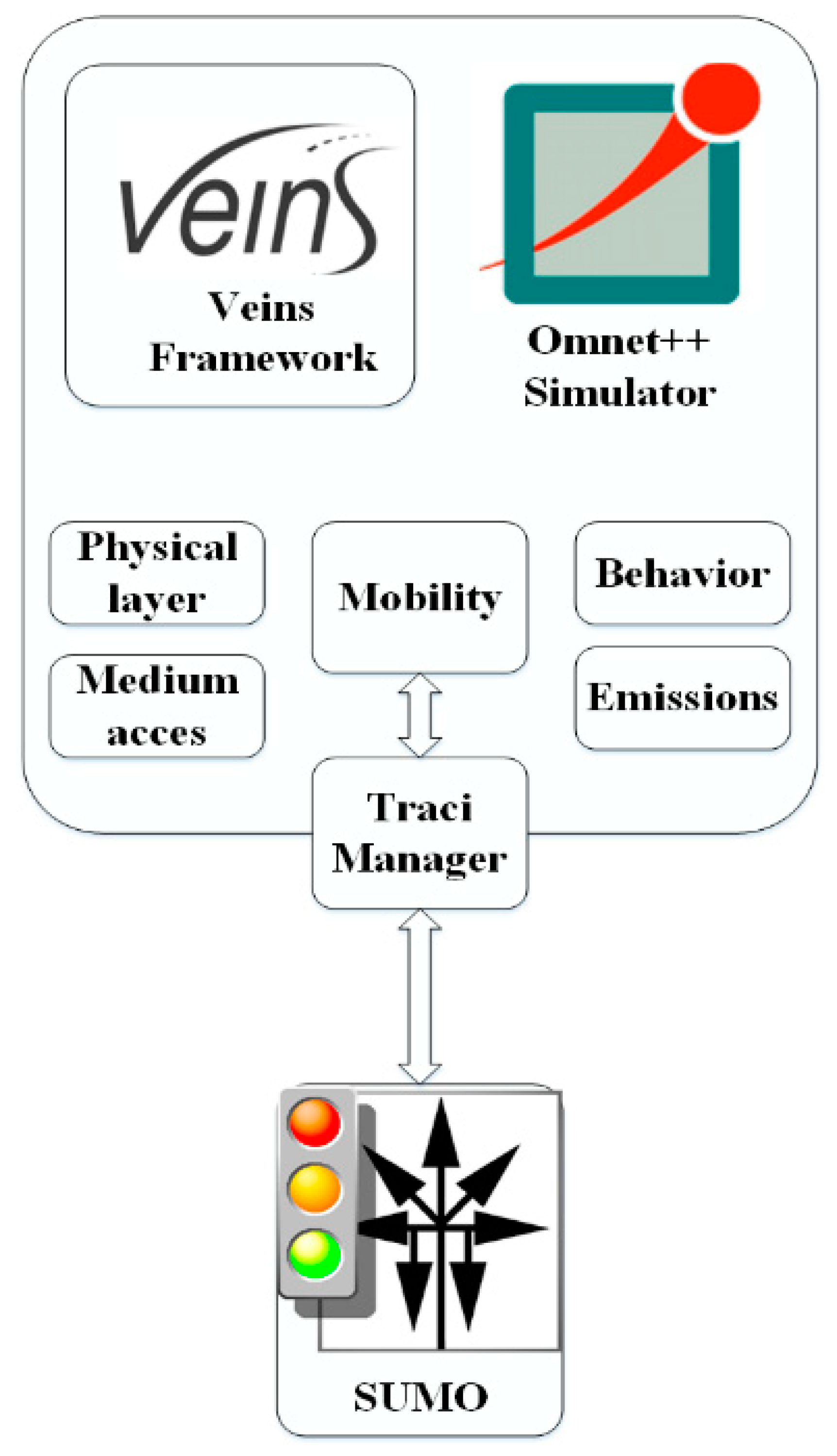
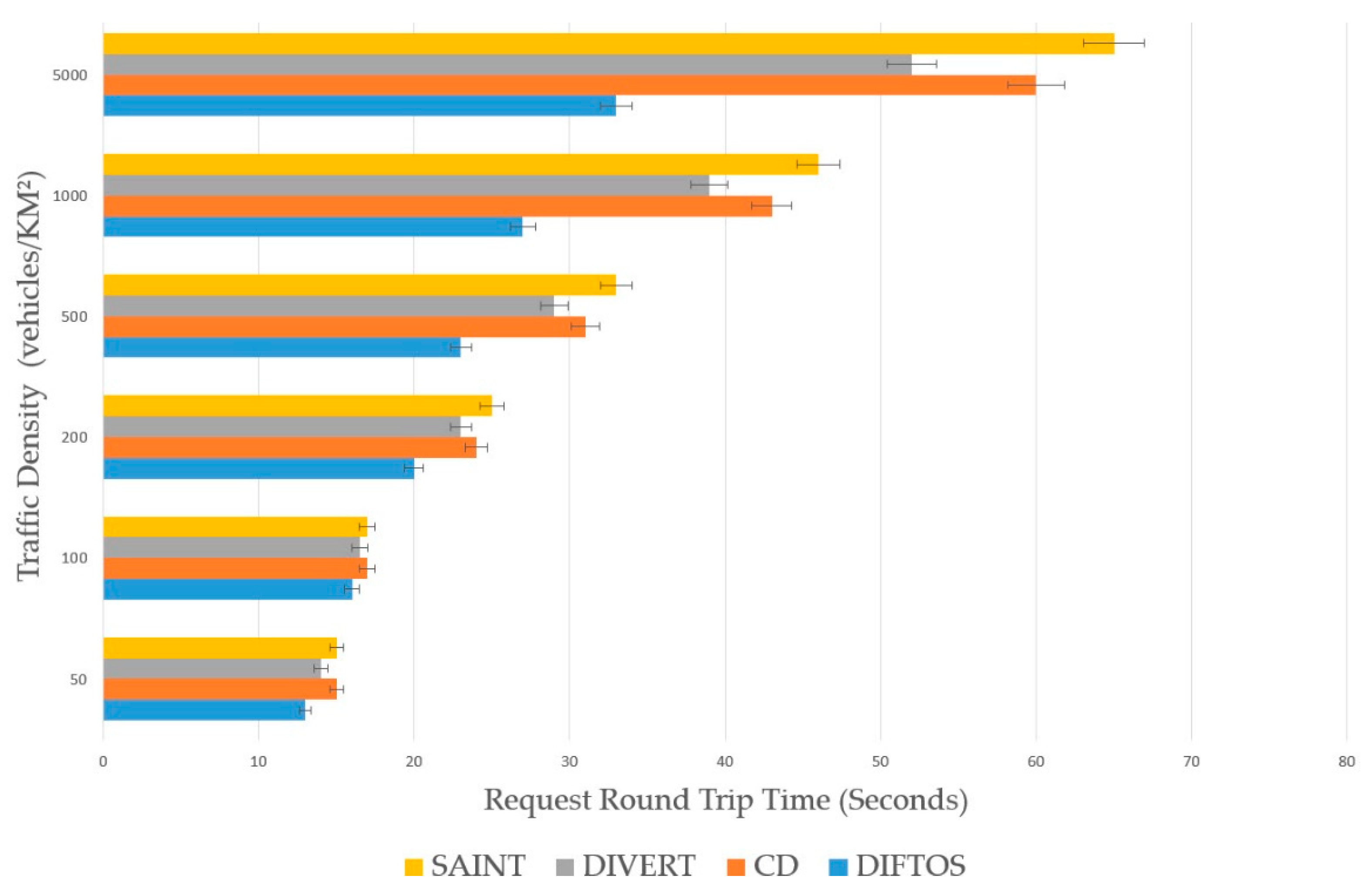
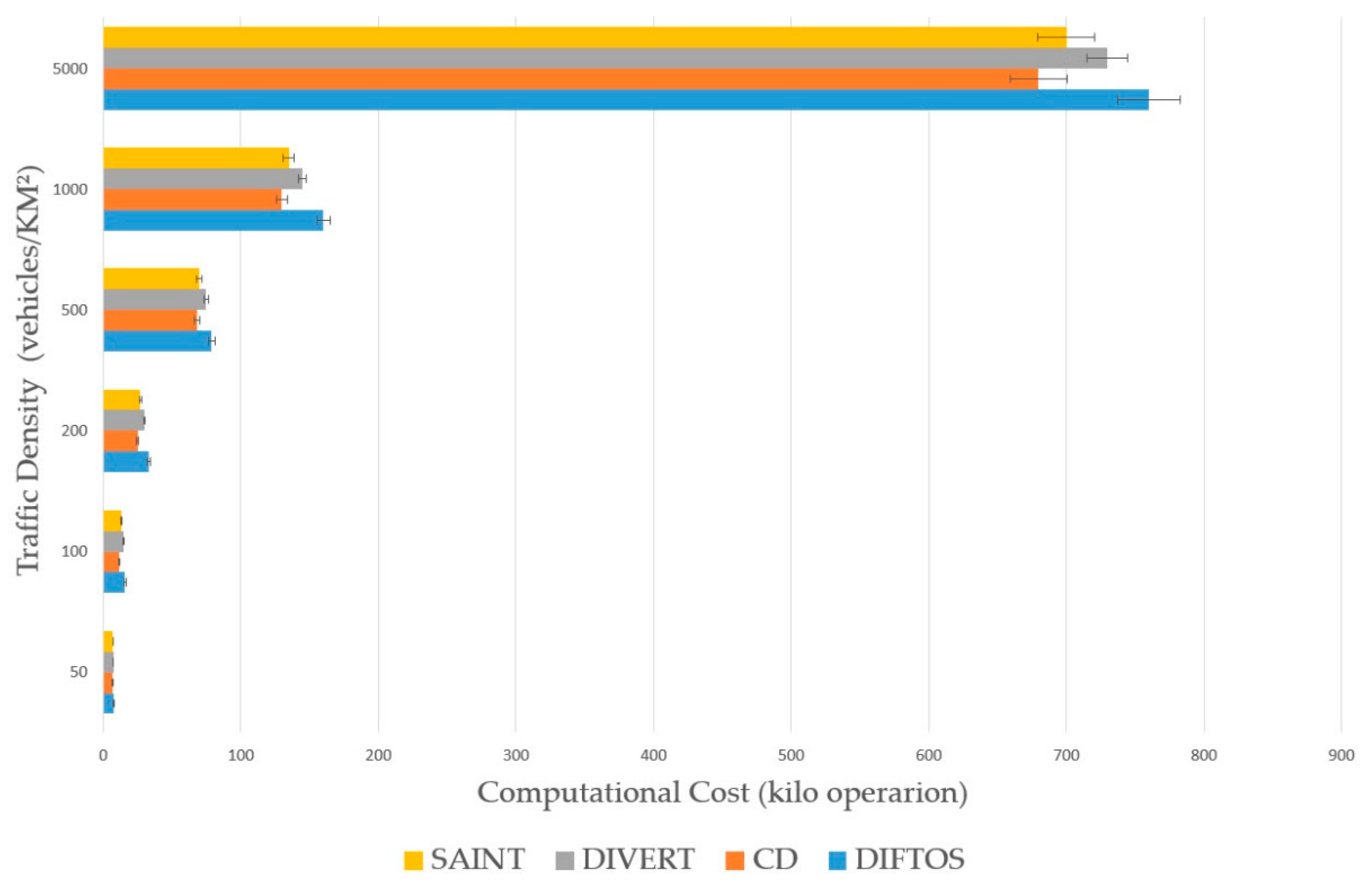
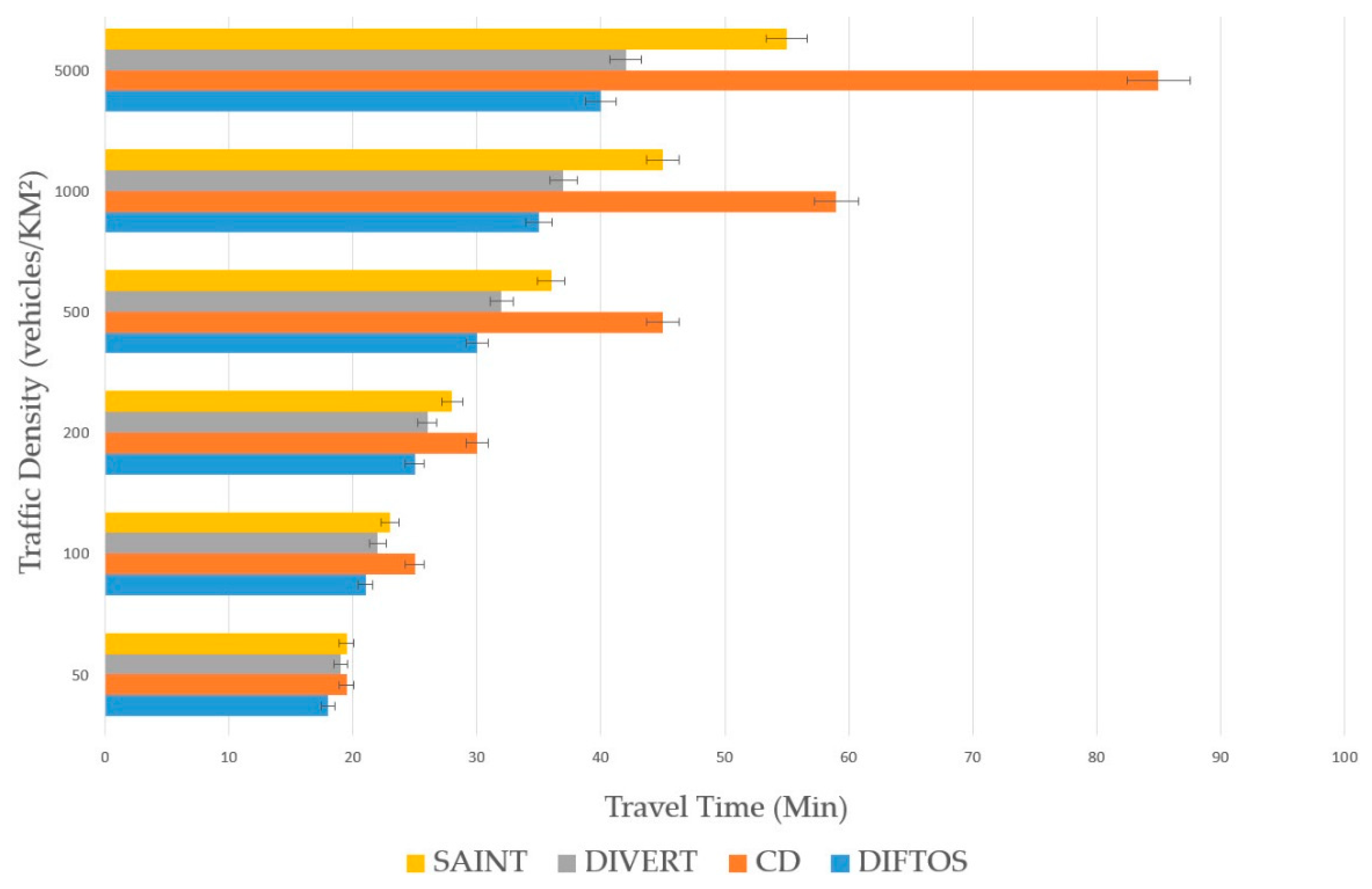

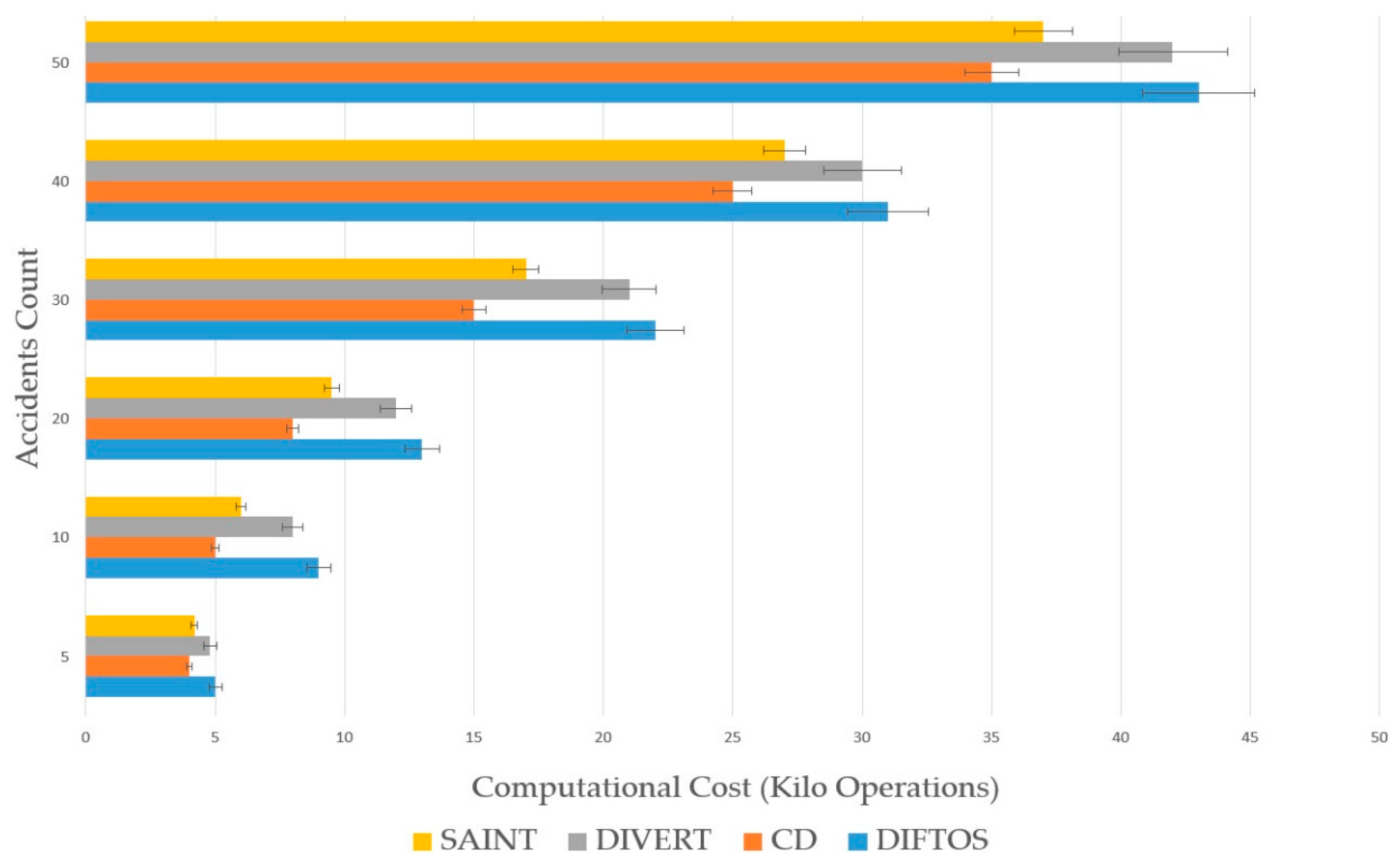
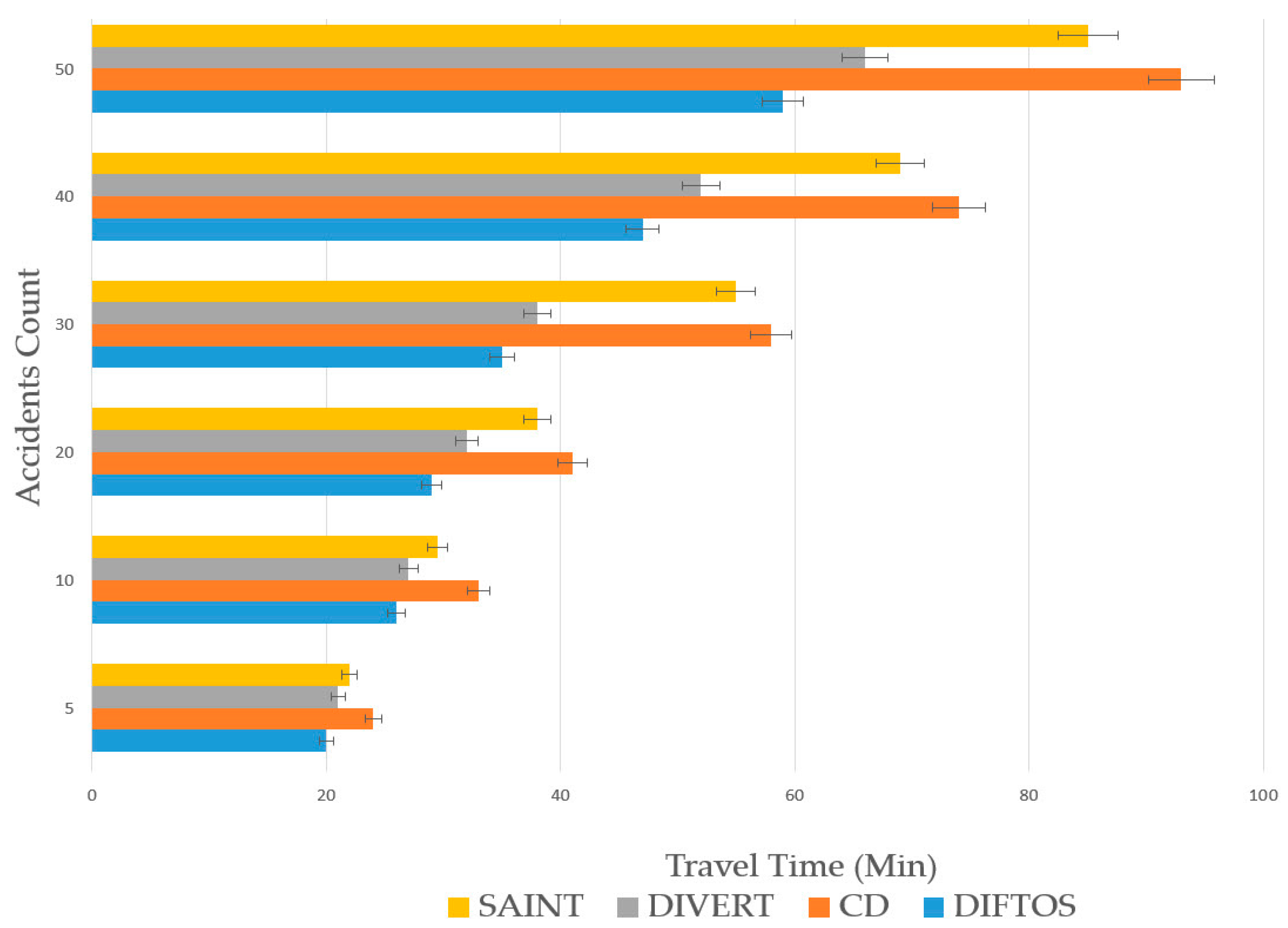
| System | Infrastructure Dependency | Server Architecture | Server Design | Congestion Treatment Policy |
|---|---|---|---|---|
| DIFTOS | Infrastructure-Less | Distributed | Hierarchy of Vehicular Servers (Vehicles) | Path requests for roads reservation (Congestion will never occur) |
| SAINT [15] | RSU + Cellular network | Centralized | Traffic Center (Computer) | Traffic estimation (Possible congestion) |
| DIVERT [16] | Cellular network | Partially Distributed | Traffic Center + Vehicular Servers (Computer + Vehicles) | Congestion detection (Possible congestion) |
| RTP [13] | RSU + Cellular network | Centralized | Traffic Center (Computer) | Congestion mitigation based on path planning (Possible congestion) |
| NRR [14] | RSU + Cellular network | Centralized | Traffic Center (Computer) | Heuristic rerouting to avoid congestion (Possible congestion) |
| RoadRunner [17] | Cellular network | Distributed | Mobile app + Centralized Server (Computer + smart phones) | Tokens for road reservation (Congestion will never occur) |
| Symbol | Description |
|---|---|
| Road network graph that represents the city map | |
| I | Set of all vertices in the road network graph |
| Set of all edges in the road network graph | |
| Set of all vehicles in the city | |
| The road segment from intersection to intersection | |
| Set of successive time slots | |
| The mean of the speed of all vehicles driving within the traffic flow on the road segment within the time slot | |
| The velocity of the vehicle in road segment during time slot t | |
| Travel delay required to cross road segment | |
| The length of the road segment | |
| The waiting delay at intersection | |
| The capacity of the road segment | |
| The number of available positions in the road segment during time slot . | |
| The weight of road segment during time slot t | |
| The path yielded by connecting the road segments from to | |
| Road reservation matrix of the road set during the period | |
| The quota limit of the road during time slot |
| Parameter | Description |
|---|---|
| Network simulator | Omnet++ 5 |
| Traffic simulator | SUMO 0.27.1 |
| Map source | Open street map |
| Simulated location | Part of Beijing city, China |
| Simulated area | 10 km × 10 km |
| Parameter | Value |
|---|---|
| PHY model | 802.11 p |
| Channel frequency | 5.890 × 109 Hz |
| Propagation model | Two ray |
| MAC model | EDCA |
| Propagation distance | 450 m |
| Maximum hop | 15 |
| Fading model | Jakes model rayleigh fading |
| Shadowing model | LogNormal |
| Antenna model | Omnidirectional |
| Transmission power | 20 mW |
© 2018 by the authors. Licensee MDPI, Basel, Switzerland. This article is an open access article distributed under the terms and conditions of the Creative Commons Attribution (CC BY) license (http://creativecommons.org/licenses/by/4.0/).
Share and Cite
Zhang, W.; Aung, N.; Dhelim, S.; Ai, Y. DIFTOS: A Distributed Infrastructure-Free Traffic Optimization System Based on Vehicular Ad Hoc Networks for Urban Environments. Sensors 2018, 18, 2567. https://doi.org/10.3390/s18082567
Zhang W, Aung N, Dhelim S, Ai Y. DIFTOS: A Distributed Infrastructure-Free Traffic Optimization System Based on Vehicular Ad Hoc Networks for Urban Environments. Sensors. 2018; 18(8):2567. https://doi.org/10.3390/s18082567
Chicago/Turabian StyleZhang, Weidong, Nyothiri Aung, Sahraoui Dhelim, and Yibo Ai. 2018. "DIFTOS: A Distributed Infrastructure-Free Traffic Optimization System Based on Vehicular Ad Hoc Networks for Urban Environments" Sensors 18, no. 8: 2567. https://doi.org/10.3390/s18082567



